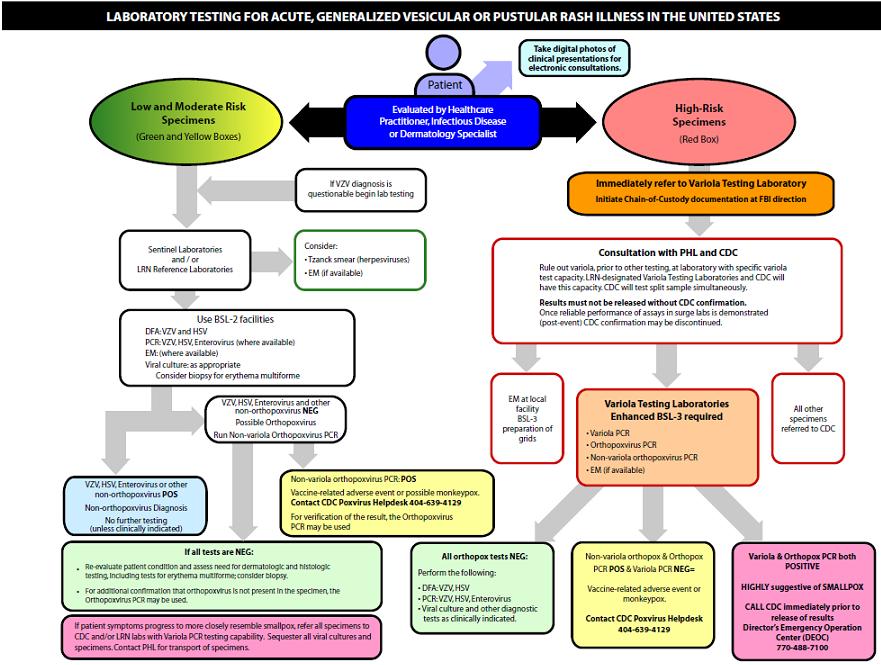Smallpox laboratory tests
|
Smallpox Microchapters |
|
Diagnosis |
|---|
|
Treatment |
|
Case Studies |
|
Smallpox laboratory tests On the Web |
|
American Roentgen Ray Society Images of Smallpox laboratory tests |
|
Risk calculators and risk factors for Smallpox laboratory tests |
Editor-In-Chief: C. Michael Gibson, M.S., M.D. [1]; Associate Editor(s)-in-Chief: João André Alves Silva, M.D. [2]
Overview
Laboratory Findings
There are laboratory tests to specifically identify the smallpox virus. However, in a patient with low to medium level of suspicion of smallpox, a false-positive result would have a great personal and social impacts. Therefore these tests must be used cautiously, and according to certain guidelines.[1][2][3][4]
The algorithm below describes the laboratory protocol for a patient who presents with a generalized vesicular or pustular rash. This algorithm is based on the risk level of the patient to be infected with smallpox.[1]
Laboratory Confirmation
Laboratory Criteria for Confirmation
- Polymerase chain reaction (PCR) identification of variola DNA in a clinical specimen, OR
- Isolation of smallpox (variola) virus from a clinical specimen (WHO Smallpox Reference laboratory or laboratory with appropriate reference capabilities) with variola PCR confirmation.
Laboratory diagnostic testing for variola virus should be conducted in a CDC Laboratory Response Network (LRN) laboratory utilizing LRN-approved PCR tests and protocols for variola virus. Initial confirmation of a smallpox outbreak requires additional testing at CDC.
Note: Generic orthopox PCR and negative stain electron microscopy (EM) identification of a pox virus in a clinical specimen are suggestive of an 'orthopox ' virus infection but not diagnostic for smallpox.
References
- ↑ 1.0 1.1 Moore, Zack S; Seward, Jane F; Lane, J Michael (2006). "Smallpox". The Lancet. 367 (9508): 425–435. doi:10.1016/S0140-6736(06)68143-9. ISSN 0140-6736.
- ↑ Seward JF, Galil K, Damon I, Norton SA, Rotz L, Schmid S; et al. (2004). "Development and experience with an algorithm to evaluate suspected smallpox cases in the United States, 2002-2004". Clin Infect Dis. 39 (10): 1477–83. doi:10.1086/425500. PMID 15546084.
- ↑ Besser JM, Crouch NA, Sullivan M (2003). "Laboratory diagnosis to differentiate smallpox, vaccinia, and other vesicular/pustular illnesses". J Lab Clin Med. 142 (4): 246–51. doi:10.1016/S0022-2143(03)00146-X. PMID 14625530.
- ↑ Madeley, CR (2003). "Diagnosing smallpox in possible bioterrorist attack". The Lancet. 361 (9352): 97–98. doi:10.1016/S0140-6736(03)12241-6. ISSN 0140-6736.
